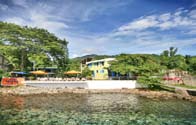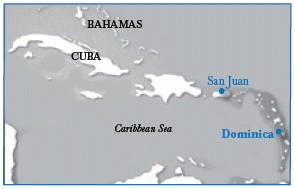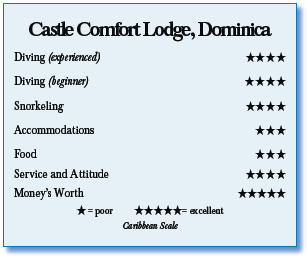Castle Comfort Lodge, DominicaContents of this Issue: Castle Comfort Lodge, Dominica Will Katie PriceÕs Breast Implants Explode Underwater? California Legislature Declares Diving ÒHazardousÓ Researchers Face Criminal Charges for Giving Sheep the Bends The Risks of Oxygen at Increased Depth The Unprofessional Side of Placing Blame Finding Diver-Friendly Life Insurance Jacques Cousteau: The Sea King Editorial Office: Ben Davison Publisher and Editor Undercurrent 3020 Bridgeway, Suite 102 Sausalito, CA 94965 a Caribbean dive and eco-tour feast at reasonable prices from the September, 2010 issue of Undercurrent
Dear Fellow Diver: The waters of Dominica have one of the better ranges of critters and corals in the Caribbean, but with the water filled with plankton and detritus from hourly rainfalls and therefore lousy visibility during my June week, you would have had to be one determined diver to find it. I did. Dominica (pronounced Dome-i-NEE-kah) is an actively volcanic island midway in the Lesser Antilles island chain between Puerto Rico and Tobago. Its unspoiled character, rugged geography, waterfalls, lush rainforests and bird life draw as many tourists to its interior as to its reefs. Landing at Melville Hall airport near Marigot, on Dominica’s northeast coast, means you’ll taxi over pot-holed switchbacks through rainforested volcanic highlands for 90 minutes to reach Castle Comfort Lodge, an aging two-story hotel with volleyball courtsized grounds overlooking the Caribbean Sea. Dive Dominica is a basic operation with neither a dive shop nor a place to nurse a sick camera housing back to health. There is a gear rental room and a crowded gear storage room with first-come, first-served hanger and rack space.
There’s an outdoor showerhead, garden hose, gear rinse tank (filled fresh each morning but briny after the dive boats return) and a tank for cameras (decent all day). Next to a pair of kayaks, an eyesore of sloppy-looking cans and other items wasn’t tidied up all week. Sadly, owner Derek
Perryman died unexpectedly
of a heart attack
at age 55 and was given
a sea burial just weeks
before we arrived.
Derek was a genial fellow
who, 20 years ago at DEMA, cajoled Undercurrent staff to get a
review, saying he didn’t have the money to
advertise and he was struggling. Today, his wife Ginette, smiling daughter Arienne and cheerful son Daniel continue to run both the lodge and dive operation, with shyer younger brother Yannick helping out. While there was no formal briefing on the operation, Markus, a helpful young Dominican tending the rental gear, answered all my questions. There would be a two-tank boat dive daily, starting at 8:30 a.m. and returning before 1 p.m. Afternoons were for shore diving, land excursions, walks into nearby Roseau, or chilling by the three-foot-deep wading pool.(On its website, the lodge calls this kiddie pool a “hot tub.”) The afternoon my spouse and I arrived, we joined a whale watching boat ($50 per person), and within 20 minutes of leaving the dock, pantropical spotted dolphins leaped from the water and surrounded the boat, so many that our captain estimated their numbers at 300. The rest of the trip was a bust. We were the only two Castle Comfort guests on a boat with a tour group of 30 hard partiers. Stopping the boat to quietly scan the water with hydrophones was the party tour’s cue to talk and laugh even more loudly, irritating the captain to no end. “I can’t work under these conditions,” he said to me. The next day I was ready to dive, but when I poked my head under the water (which ranged between 79 to 85 degrees all week), I had no more than 30 feet of visibility. I consoled myself with photographing commoners like longsnout butterfly fish, social feather dusters and blackbar soldierfish, but I did shoot an uncommon red-banded lobster that adorns the front cover of Paul Humann’s Reef Creature Identification, as well as many other “personal firsts,” surprising since I’ve made hundreds of dives in the Caribbean. That afternoon, I made two shallow solo dives in front of the lodge. Runoff from a nearby stream carried bits of dull brown vegetation that coated the boulder-covered bottom. Between hundreds of basketball- to kettle drum-sized boulders were sea urchins, and underneath most of them were nimble-spray crabs with meaty pinchers. Fire worms, yellowline arrow crabs, Pederson cleaner shrimp, delicate corallimorphs, disc-shaped cnidarians and many species of reef fish were here as well. Near the dock, anemones crawled with squat anemone shrimp. A watchman goby stood guard outside a burrowing shrimp’s hole. When the goby was disturbed, it darted into the hole, warning the shrimp to button up. When the coast was clear, the goby took up its position and the shrimp continued its excavations. I found two batfish and once, after passing above a patch of garden eels, I found both a delicate Atlantic long-armed octopus performing a variety of poses and also a scaly-tailed mantis. Its huge, searchlight-like eyes followed me closely as I kept a respectful distance from this well-known “thumb-splitter.” On the eve of a full moon, two spiny sea urchins were gently crossing their spine tips with each other. Suddenly, a puff of milky “smoke” emerged from the top of one of them, and I managed to capture a mating ritual, something special. My boat dives were from the MV Olga, one of five boats owned by Dive Dominica. A 47-foot aluminum catamaran powered by twin 270-hp Cummins turbos, it can hold 24 divers, but when the head count got much above 12, a second boat was used. The dive site and safety briefings were thorough, and a full complement of safety gear was carried on board. One mask and one camera bucket were provided. Though we were told to be back on the boat in an hour, my dives lasted longer. Reginald, the serious 30-ish skipper a.k.a. “Stinger,” took us to Champagne, where the volcanic action releases tickling bubbles of sulfurous gas. At a number of spots, the barrel sponges were so large and plentiful they rivaled Little Cayman, and the dropoff into the deep blue was just as profound. The brilliant colors of the sponges and zoanthids, and the profusion of hydroids at sites like Swiss Cheese, Scott’s Head Drop Off and the Pinnacles stood out even in the relatively low visibility. Giant basket stars, banded coral shrimp and many species of eel were prevalent. Not-so-common species included white nose pipefish, snapping shrimp, orange featherstar shrimp, batwing crab and nudibranchs. On a guided night boat dive at Champagne, divemaster Kevin psyched us up for the possibility of an encounter with the Thing, an elongated segmented worm. Divemaster Inman, an eagle-eyed critter spotter, said that usually only the first person shining their light on it sees it, since it withdraws into its hidey hole immediately after being illuminated. True to Inman’s prediction, Kevin spotted it but I missed it. No matter. On the face of a ledge, a swimming crab nestled near a beautiful orange ball corallimorph. In a large dark crevice, a channel clinging crab, whose carapace seemed a foot across, looked menacing. In the sandy shallows, a grass squid hovered. The best night dive ever, said an experienced diver. (All divers were American, about a third sported cameras and regardless of the murk, they raved about the diving.) All our boat dives were in the protected waters of Scott’s Head Soufriere
Marine Reserve but fishing is permitted elsewhere. I saw four young men next to Dive
Dominica’s dock pull in a seine net some 30 yards in diameter, right next to my happy
shore diving grounds. The next day, they cast their nets from Dive Dominica’s dock.
Daniel told me that fishing was not prohibited in most places, and for a resort to
forbid it would both deny the local people their food and bring some retaliation, perhaps in the form of having anchor lines
cut in the dead of night. I had hoped for the cuisine to match the bountiful fruits of the rainforest but it was expensive and more or less unremarkable. The breakfast plan meant you could have coffee or tea, a juice pitcher, and one course, like a two-egg omelet and a pancake substituting for toast. Lunch often consisted of rather boring pumpkin and ginger or calaloo soup, plus a cheese sandwich for $US9; a cheeseburger with fries ran $9.50. I passed on the dinner plan ($30 per night) and went a la carte: a salad with pineapple and ham pizza ($19), a fish or chicken roti ($8.25 each), or seafood dinner with a couple of Creole sides ($32). Beer was $3 for an 8.45 oz bottle for the local Kubuli; wine about $7 per glass, and a cocktail $6.50. We bought rum and wine at a local store for U.S. prices instead. On the plus side, our small (9.5’x 14’) room was clean, with a 13-inch TV and intermittent wireless internet access, but no table for a camera setup. I slept well on the king-sized bed, and the bathroom contained a roomy shower. There were a couple of 115-volt outlets, so with the multi-outlet adapter I always carry, battery charging was no problem. The AC was powerful enough to keep at bay the 85-degree days and 85 percent humidity. A pleasant balcony contained a table and a couple of chairs. The hotel provides plenty of potable water, yet some guests who ignored warnings regretted drinking the brownish tap water taken from the surrounding hills. Bring earplugs: On the weekends, music in the resort next door blares loudly way past midnight. To get a taste of the nondiver’s Dominica, we spent three days at the Papillote Wilderness Retreat. (We spent our last night at Calibishie Lodges Hotel so we’d be close to the airport in Marigot for our 7 a.m. departure.) Papillote perches on a beautiful mountain overlook, nestled among little streams and waterfalls that emanate from the waters that also feed Trafalgar Falls, a five-minute walk up the hill. The grounds were established with an artist’s eye. We used our room with a view of the Roseau Valley as a base for guided land travel -- hiking to Middleham Falls, swimming up Titou Gorge (a site seen in Pirates of the Caribbean), spending time at Freshwater Lake, walking the trail at Syndicate Falls, visiting Fort Cabrits and taking a boat ride up Indian River. We had sundowners in one of Papillote’s hot sulphur pools (the best being a hot-cool combo with a delicate double waterfall backdrop possessing fengshui equal to anywhere else in the world), then each night, we enjoyed gourmet meals, the likes of which I’ve not seen elsewhere in the Caribbean. We dined on rabbit, tuna wrapped in banana leaves, christophin baked with cheese, freshwater prawns and an exceptional tart key lime pie. Owner Anne Jno Baptiste spun stories of her early days on the island (she had to rebuild and replant in 1979 after Hurricane David spun like a blender for three days in the Roseau Valley), while bats swooped through the open air terrace restaurant. In the morning, the guava juice, cocoa, banana pancakes and omelets made a lunch almost unnecessary. So who should go to Castle Comfort Lodge and Dive Dominica? Divers whose needs for creature comfort are simple: no fancy buffets, no exercise rooms, no walks on a palmlined beach, no lush on-premises landscaping, no dive shop, no shelves lined with tourist gimcrack. It’s a great place to mix shore and boat diving with the chance to photograph interesting macro and other atypical marine life. Divers seeking more conventional digs with easy access to town often prefer the Fort Young Hotel. Regardless, it is a mistake for any traveler not to sample Dominica’s rugged, unspoiled, natural beauty, unrivaled anywhere else in the Caribbean, St. Lucia being the possible exception. My week was not just a dive vacation but a unique diving and rainforest vacation, unlike anything else the Caribbean offers. -- S.P.
|

I want to get all the stories! Tell me how I can become an Undercurrent Online Member and get online access to all the articles of Undercurrent as well as thousands of first hand reports on dive operations world-wide
| Home | Online Members Area | My Account |
Login
|
Join
|
| Travel Index |
Dive Resort & Liveaboard Reviews
|
Featured Reports
|
Recent
Issues
|
Back Issues
|
|
Dive Gear
Index
|
Health/Safety Index
|
Environment & Misc.
Index
|
Seasonal Planner
|
Blogs
|
Free Articles
|
Book Picks
|
News
|
|
Special Offers
|
RSS
|
FAQ
|
About Us
|
Contact Us
|
Links
|
3020 Bridgeway, Ste 102, Sausalito, Ca 94965
All rights reserved.


 Little did
he know that Ben Davison had already scheduled
an anonymous trip, and a few months
later enough of our readers showed up to put
his unknown operation in the black.
Little did
he know that Ben Davison had already scheduled
an anonymous trip, and a few months
later enough of our readers showed up to put
his unknown operation in the black. Hence, divers
won’t see bigger fish or schooling reef
fish except in protected areas and spots
affording natural protection (such as
under docks).
Hence, divers
won’t see bigger fish or schooling reef
fish except in protected areas and spots
affording natural protection (such as
under docks). Diver’s Compass: The seven-night dive package including breakfast was
about $900 for me and $600 for my non-diving spouse, tax included,
and airport transfers by taxi . . . Because the airport has no working
runway lights, thus, no night landings, any flight delays after 4
p.m. with a connection out of Puerto Rico means you might spend a night
in San Juan or an island like Antigua along the way; runway lights are
being installed and may be operational by year’s end . . . Weight limitations
on LIAT were 15 pounds for the single carryon permitted, 50
pounds for one checked bag; to save weight, I brought my computer, mask
and snorkel, and rented everything else for less than $90 for the week . . . Nitrox was
$12 per tank, the night boat dive was $65; wireless internet access was complimentary .
. . A week’s pass to Dominica National Parks was $12 each, saving $5 each on separate
admissions to each park; Castle Comfort can recommend good guides for your trip . . .
Hotel websites:
Diver’s Compass: The seven-night dive package including breakfast was
about $900 for me and $600 for my non-diving spouse, tax included,
and airport transfers by taxi . . . Because the airport has no working
runway lights, thus, no night landings, any flight delays after 4
p.m. with a connection out of Puerto Rico means you might spend a night
in San Juan or an island like Antigua along the way; runway lights are
being installed and may be operational by year’s end . . . Weight limitations
on LIAT were 15 pounds for the single carryon permitted, 50
pounds for one checked bag; to save weight, I brought my computer, mask
and snorkel, and rented everything else for less than $90 for the week . . . Nitrox was
$12 per tank, the night boat dive was $65; wireless internet access was complimentary .
. . A week’s pass to Dominica National Parks was $12 each, saving $5 each on separate
admissions to each park; Castle Comfort can recommend good guides for your trip . . .
Hotel websites: 